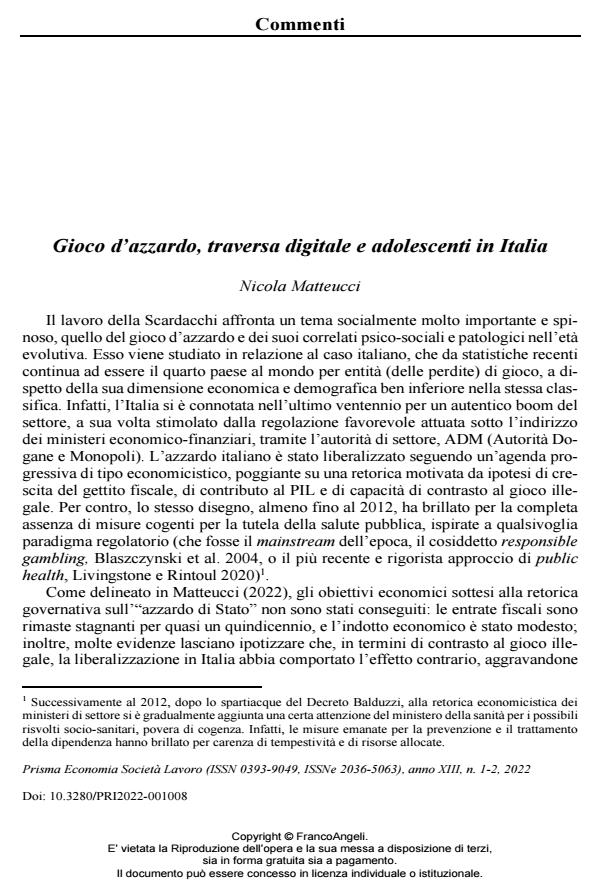Gioco d’azzardo, traversa digitale e adolescenti in Italia
Titolo Rivista PRISMA Economia - Società - Lavoro
Autori/Curatori Nicola Matteucci
Anno di pubblicazione 2023 Fascicolo 2022/1-2
Lingua Italiano Numero pagine 8 P. 101-108 Dimensione file 188 KB
DOI 10.3280/PRI2022-001008
Il DOI è il codice a barre della proprietà intellettuale: per saperne di più
clicca qui
Qui sotto puoi vedere in anteprima la prima pagina di questo articolo.
Se questo articolo ti interessa, lo puoi acquistare (e scaricare in formato pdf) seguendo le facili indicazioni per acquistare il download credit. Acquista Download Credits per scaricare questo Articolo in formato PDF

FrancoAngeli è membro della Publishers International Linking Association, Inc (PILA)associazione indipendente e non profit per facilitare (attraverso i servizi tecnologici implementati da CrossRef.org) l’accesso degli studiosi ai contenuti digitali nelle pubblicazioni professionali e scientifiche
- Steinberg, L. (2008). A social neuroscience perspective on adolescent risk-taking. Developmental review, 28(1), pp. 78-106.
- Storer, J., Abbott, M., & Stubbs, J. (2009). Access or adaptation? A meta-analysis of surveys of problem gambling prevalence in Australia and New Zealand with respect to concentration of electronic gaming machines. International Gambling Studies, 9(3), pp. 225-244.
- Pennay, A.E., & Measham, F.C. (2016). The normalization thesis - 20 years later. Drugs: Education, Prevention and Policy, 23(3), pp. 187-189
- Schüll D.N. (2014) Addiction by design: Machine gambling in Las Vegas, Princeton: Princeton University Press.
- Andrie, E.K., Tzavara, C.K., Tzavela, E. et al. (2019). Gambling involvement and problem gambling correlates among European adolescents: results from the European Network for Addictive Behavior study. Social Psychiatry and Psychiatric Epidemiology, 54, pp. 1429-1441.
- Babor, T., Caetano, R., Casswell, S., Edwards, G., Giesbrecht, N., ... & Graham, K. (2010). Alcohol: no ordinary commodity: research and public policy. Oxford: University Press.
- Blaszczynski, A., Ladouceur, R., & Shaffer, H.J. (2004). A science-based framework for responsible gambling: The Reno model. Journal of Gambling studies, 20(3), pp. 301-317.
- Bruni, L., & Stanca, L. (2008). Watching alone: Relational goods, television and happiness. Journal of Economic Behavior & Organization, 65(3-4), 506-528.
- Capellani, G. (2018). Crescere nell’era digitale. L’uso delle nuove tecnologie nell’infanzia, nell’età scolare e adulta: quale futuro?. Milano: Edilibri
- Capitanucci, D., & Smaniotto, R. (2016). I danni collaterali del gioco d’azzardo: riflessioni per l’agenda di ricerca. Prisma, 3, pp. 103-119.
- Carran, M. (2013). Minors and gambling regulation. European Journal of Risk Regulation, 4(4), pp. 509-520.
- Croce, M., & Jarre, P. (2017). Il disturbo da gioco d’azzardo, un problema di salute pubblica. Indicazioni per la comprensione e per l’intervento. Cuneo: Publiedit.
- Donati P. (1986), Introduzione alla Sociologia Relazionale, Milano: FrancoAngeli.
- Gainsbury, S., Angus, D., & Blaszczynski, A. (2019). Isolating the impact of specific gambling activities and modes on problem gambling and psychological distress in internet gamblers. BMC Public Health, 19(1), pp. 1-16.
- Icenogle, G., & Cauffman, E. (2021), Adolescent decision making: A decade in review. Journal of research on adolescence, 31, pp. 1006-1022.
- Livazović, G., & Bojčić, K. (2019). Problem gambling in adolescents: what are the psychological, social and financial consequences?. BMC Psychiatry, 19(1), pp. 1-15.
- Livingstone, C., & Rintoul, A. (2020). Moving on from responsible gambling: a new discourse is needed to prevent and minimise harm from gambling. Public Health, 184, pp. 107-112.
- Matteucci, N. (2010). Strategies for digital television: DTT in Italy. The International Journal on Media Management, 12(3-4), pp. 159-181.
- Matteucci, N. (2020). Digital agendas, regional policy and institutional quality: assessing the Italian broadband plan. Regional Studies, 54(9), pp. 1304-1316.
- Matteucci, N. (2022). Il boom italiano del gioco d’azzardo: mercato, istituzioni e politiche. Stato e mercato, 42(2), pp. 327-361.
- Matteucci, N., Minnetti, S., & Nanni, P. (2016). Economia Civile e gioco d’azzardo: la rete Slot Mob e l’esperienza delle Marche. Prisma, 3, pp. 168-191.
- Paulsen, D.J., Platt, M.L., Huettel, S.A., & Brannon, E.M. (2011). Decision-making under risk in children, adolescents, and young adults. Frontiers in Psychology 2, 72.
- Van Hoorn, J., Crone, E.A., & Van Leijenhorst, L. (2017). Hanging out with the right crowd: Peer influence on risk‐taking behavior in adolescence. Journal of Research on Adolescence, 27(1), pp. 189-200.
- World Health Organization. (2015). Public health implications of excessive use of the internet, computers, smartphones and similar electronic devices: Meeting report, Main Meeting Hall, Foundation for Promotion of Cancer Research, National Cancer Research Centre, Tokyo, Japan, 27-29 August 2014. World Health Organization.
- Yani-de-Soriano, M., Javed, U., & Yousafzai, S. (2012). Can an industry be socially responsible if its products harm consumers? The Case of Online Gambling. Journal of Business Ethics, 110(4), pp. 481-497.
Nicola Matteucci, Gioco d’azzardo, traversa digitale e adolescenti in Italia in "PRISMA Economia - Società - Lavoro" 1-2/2022, pp 101-108, DOI: 10.3280/PRI2022-001008